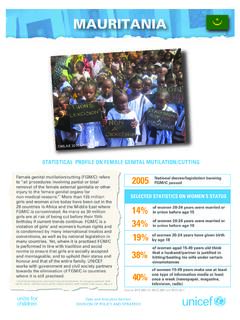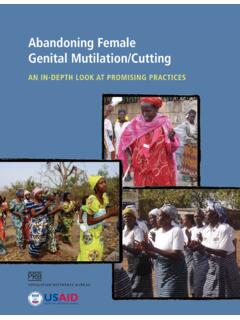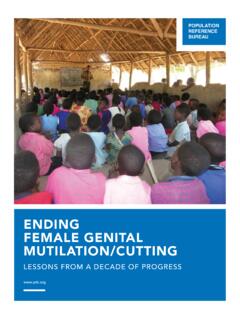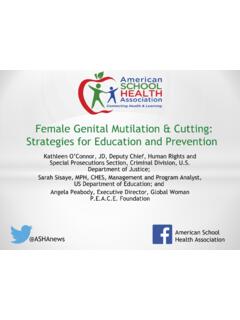Transcription of care of women and girls affected by female genital ...
1 A national approach to service coordinationImproving the health care of women and girls affected by female genital mutilation / cuttingSexual Health ServicesImproving the health care of women and girls affected by female genital mutilation / cutting : A national approach to service coordinationLynne Jordan, Chief Executive Officer Family Planning Victoria, Koula Neophytou, Statewide FARREP Facilitator Family Planning Victoria and Catherine James, Senior Project Manager Family Planning VictoriaPublished January 2014 Family Planning Victoria, 901 Whitehorse Road, Box Hill, PO Box 1377, Box Hill Victoria 3128, T/ 03 9257 0100 F/ 03 9257 0112 E/ 978-0-9871928-3-7 Family Planning Victoria 2014 No part of this publication may be reproduced by any process, except in accordance with the provisions of the Copyright Act This publication may be of assistance to you. Every effort has been made to ensure that the information provided is correct. Family Planning Victoria does not guarantee that the publication is without flaw of any kind or is wholly appropriate for your particular purposes and therefore disclaims all liability for any error, loss or other consequence that may arise from you relying on any information in this publication.
2 Every attempt has been made to trace and acknowledge copyright, though in some cases this may not have been possible. Family Planning Victoria apologises for any accidental infringement and would welcome any information to redress the Family Planning Victoria would like to thank the Victorian health and community service proiders who contributed to the original version of this resource. This version of the resource depended heavily on input from state and territory Family Planning Organisations. Their input is greatly appreciated. This project received funding from the Australian Government. Family Planning Victoria acknowledges the support of the Victorian Government in developing the original edition of this the guide 2 Introduction and policy context 4 What is female genital mutilation / cutting ?
3 5 Policy context 5 Understanding female genital mutilation / cutting 8 Why FGM/C occurs 9 Harmful consequences of FGM/C 10 Working with women and girls 12 Care plan flow chart 15 Flow chart 16 Countries known to practise FGM/C 17 Interpreting services 17 The journey to Australia 18 Talking about FGM/C with women and girls 18 Health impacts of FGM/C
4 18 Types of FGM/C 19 Assessment considerations 19 Care planning considerations 20 Information and referral services 20 Duty of care 21 Case studies 24 Service coordination partnerships and training 26 References 27 Appendices 282 Improving the health of women and girls affected by female genital mutilation / cuttingIntroduction and policy contextIntroductory information, including the purpose of this guide, an explanation of service coordination, guiding principles and relevant policy regarding FGM/CUnderstanding female genital mutilation / cutting Information about FGM/C.
5 Including the different types, what is known, why it occurs and the health impacts for affected women and girls Working with women and girlsFlow chart identifying key strategies and practice to support the care of women and girls , including initial needs identification and assessment, duty of care and case studiesService coordination partnerships and trainingInformation to support agencies in working together, including developing local partnerships, identifying resource people and accessing trainingUsing the resourceThis national resource supports health and community service providers in all states and territories, who work with women and girls affected by female genital mutilation / cutting (FGM/C). It provides them with the information they need to talk with women and girls about FGM/C and its potential impact on their health and national edition is based on a previous publication developed for Victorian health and community service providers. The information, strategies and practice described in this guide are based on the Victorian Service Coordination principles and practices.
6 See < >.Where they exist, information and references are included for each state and territory. When the information and/ or references are extensive, they have been loaded on a webpage and listed by state and territory. It may be helpful to print the pages relevant to your state or territory. See < >.Language used in this guide FGM/C is also known as female circumcision or female genital cutting . The word mutilation is used to emphasise both the severity and harmful effect of the practice and the violation of the rights of women and girls1. In 1990, this term was formally accepted by the Inter-African Committee on Traditional Practices Affecting the Health of women and working with community members, it is recommended that service providers use more culturally sensitive language such as traditional cutting or circumcision . Appendix A provides a list of culturally specific terms used in reference to the word cutting is intended to reflect the importance of using non-judgemental language with communities known to practise FGM/C.
7 The term FGM/C is used throughout this document, except when referencing or quoting other World Health Organization, 2008, Eliminating female genital mutilation : An Interagency statement, WHO, Geneva, viewed November 2011, < >.3 Family Planning Victoria 2014 in 2011, there were 109,000 people living in Australia who were born in countries that practise female genital mutilation / cutting 4 Improving the health of women and girls affected by female genital mutilation / cuttingIntroduction and policy contextThis resource provides the information health care professionals need to support the development of partnerships between services to respond to the health care needs of women and girls affected by female genital mutilation / cutting (FGM/C).Consultations conducted to inform the development of this resource indicate that although many professionals would ask the question about FGM/C, this does not reflect standard practice. These consultations also indicate that many professionals feel unsure or unprepared for asking the question and discussing FGM/C with women and girls from communities that practise of the resource To improve care and referral pathways for women and girls who come from communities known to practise FGM/C To improve the capacity of service providers to identify women and girls who are affected or are at risk of being affected by FGM/CWhat is service coordination?
8 Service coordination places the client at the centre of service delivery, to ensure that they have access to the services they need, opportunities for early intervention, health promotion and improved health and care Service coordination emphasises collaborative partnerships between services and organisations. A service coordination model sets out a multi-service response to assist organisations in working together to better meet the needs of clients, reducing service duplication and ensuring better coordination of referral and The focus is on the client, with the model being driven by the needs of the key components of service coordination are initial contact, initial needs identification, assessment and care planning. Other elements include information provision, consent, referral, feedback, service delivery and contact: first contact the client has with the service Initial needs identification: broad screening to determine the best possible services, urgency and type of assessment required for the clientAssessment: the decision-making process that collects, weights and interprets relevant client information, using professional and interpersonal skills to uncover issues for informing the development of a care plan for the client5 Care planning: process of deliberation that incorporates care coordination, case management, referral, feedback, review, re-assessment, monitoring and the development of exiting plan2 Victoria.
9 Department of Health, 2009, Primary care partnerships: Service coordination, Department of Health, viewed November 2011, < >.3 Great Britain. Foreign and Commonwealth Office 2011, Multi-agency practice guidelines: female genital mutilation , HM Government, London, viewed November 2011, < >.4,5 Victoria, Department of Health 2009, Planning Victoria 20146, 7 World Health Organization 2010, female genital mutilation , WHO, Geneva, viewed April 2012 < >.8 Costello, S, Quinn, M & Tatchell, A 2012, female genital mutilation / cutting (FGM/C): A tradition in transition: report to Family Planning Victoria on Victorian demographics and international program response to FGM/C, unpublished research paper, RMIT, is female genital mutilation / cutting ?The World Health Organization (WHO) states that the term FGM/C refers to all procedures involving partial or total removal of the external female genitalia or other injury to the female genital organs for non-medical FGM/C is a harmful practice and a violation of the human rights of affected girls and women .
10 In 1997, the WHO issued a joint statement with the United Nations Children s Fund (UNICEF) and the United Nations Population Fund (UNFPA) against the practice of female genital mutilation (FGM).7It is difficult to know the precise number of women andgirls in Victoria who are affected by FGM/C. A demographic study of communities that have arrived in Australia from countries known to practise FGM/C8 using census data from the Australian Bureau of Statistics, indicates that in 2011 there were 109,000 people living in Australia who were born in countries that practise contextAustralian context New South Wales, Victoria, Queensland, South Australia, Australian Capital Territory, and Northern Territory, have legislated against the practice of FGM/C and it exists in the Criminal Codes of Western Australia and Tasmania. There is no federal legislation regarding South WalesNSW Crimes Act 1900 VictoriaThe Crimes ( female genital mutilation ) Act 1996, Children, Youth and Families Act 2005 QueenslandQLD Criminal Code: 323 B, 323 ASouth AustraliaChildren s Protection Act 1993, Criminal Law Consolidation Act 1935 Western AustraliaCriminal Code Amendment Act 2004 TasmaniaCriminal Code Amendment Act 1995 amendments not proclaimedAustraian Capital TerritoryVictims of Crime (Financial Assistance) Act 1983, Crimes Act 1900 (ACT) Part IVNorthern TerritoryCriminal Code Act.










